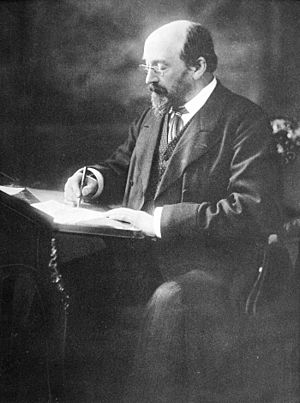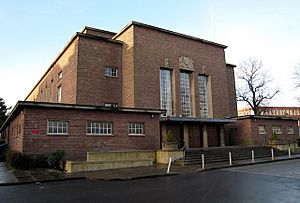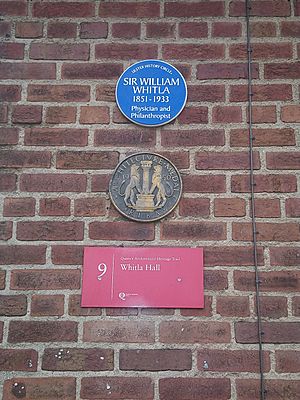William Whitla facts for kids
Quick facts for kids
Sir William Whitla
|
|
|---|---|
 |
|
| Member of Parliament for Queen's University of Belfast |
|
| In office 14 December 1918 – 16 November 1923 |
|
| Preceded by | Constituency created |
| Succeeded by | Thomas Sinclair |
| Personal details | |
| Born | 15 September 1851 Monaghan, Ireland |
| Died | 11 December 1933 Belfast, Northern Ireland |
| Nationality | British |
| Political party | Ulster Unionist Party |
| Spouse | Ada Bourne |
| Alma mater | Queen's College Belfast |
| Profession | Physician |
Sir William Whitla (born September 15, 1851 – died December 11, 1933) was an important Irish doctor and politician. He was known for his work in medicine and for serving in the British Parliament.
Contents
Growing Up in Ireland
William Whitla was born in a town called Monaghan in Ireland. He was one of twelve children in his family. His father, Robert Whitla, worked with wool and also helped people with loans.
William went to the Model School in Monaghan. When he was 15, he started learning to be a pharmacist. He worked with his brother James, who owned a chemist shop. Later, he finished his training in Belfast.
After his training, William studied medicine at Queen's College in Belfast. He earned his medical degrees in 1873.
Becoming a Doctor
After finishing his studies, William Whitla became a doctor. He worked at the Belfast General Hospital. He also spent some time learning more at a hospital in London.
While in London, he met Ada Bourne, who would become his wife. Ada was a nurse and a friend of Florence Nightingale, a very famous nurse. William and Ada got married in 1876. They moved to Belfast, where William started his own medical practice.
In 1877, he earned a special medical degree with high honors. This showed how good he was at medicine.
Helping Patients in Hospitals
William Whitla became a doctor at the Belfast Royal Hospital in 1882. He also worked at the Ulster Hospital for Children and Women. He helped many patients there for a long time.
He continued working at the Royal Victoria Hospital, which was the new name for the Belfast Royal Hospital. He retired from this important job in 1918.
Teaching and Leading in Medicine
Sir William Whitla was not just a doctor; he was also a teacher. In 1890, he became a professor at Queen's College. He taught about materia medica, which is the study of how medicines work.
He was also chosen to be the president of the Ulster Medical Society twice. This shows that other doctors respected his knowledge and leadership.
In 1902, he was given the title of Knight Bachelor. This meant he was called "Sir William Whitla" because of his important work. He was knighted by the Lord Lieutenant of Ireland in Dublin.
He also became a governor for Methodist College Belfast, a school, in 1906. He cared a lot about the school.
A Career in Politics
Sir William Whitla was also interested in politics. He believed in unionism, which meant he wanted Ireland to remain part of the United Kingdom.
In 1918, he was elected to the Parliament in London. He represented Queen's University until 1923. This was a very important role, as he helped make laws for the country.
In 1919, he was also named an Honorary Physician to the King in Ireland.
Later Years and Legacy
Sir William and Lady Whitla did not have children. They were also very wealthy. Sir William was good at investing his money, especially in oil companies. They traveled a lot, visiting places like Russia and Canada.
Sir William was also interested in the Bible. He wrote an introduction for a book by Sir Isaac Newton in 1922.
Lady Whitla passed away in 1932. Sir William Whitla died in 1933 at his home in Belfast. He was given a special public funeral and was buried in the Belfast City Cemetery.
Gifts to Education and Medicine
Sir William Whitla was very generous. He gave many gifts to help others.
He gave money to the Royal Hospital for a beautiful stained glass window. This window honored two brave doctors from Ulster. He also gave a building to the Ulster Medical Society.
After he died, his home was given to Queen's University. He also left a lot of his money to the university. He suggested that the money should be used to build a large assembly hall. The Sir William Whitla Hall was opened in 1949 at Queen's University. There is a plaque there to remember him.
He also left £10,000 to Methodist College Belfast. This money helped build the Whitla Hall at the Methodist College, which opened in 1935.
Selected Publications
- Sir Isaac Newton's Daniel and the Apocalypse; with an introductory study of the nature and the cause of unbelief, of miracles and prophecy (John Murray, 1922)
- A dictionary of treatment : including medical and surgical therapeutics (J.F. Hartz Co., Ltd., 1920)
- Elements of pharmacy, materia medica, and therapeutics (H. Renshaw, 1884)




